The weaver ant chutney comes first. There is no shock of multiple limbs, eyes and wings piled up on the plate. It is sour, fresh tasting and, scooped up with small portions of rice roti, not unpleasant. Sunita Rao of Vanastree, a women’s collective of seed savers from Sirsi, in the Western Ghats, explains that the arboreal weaver ants we have just consumed are a species 50 million years old. They are foraged by women of the Siddi community –who trace their origins back to Africa –and incorporated into their cuisine. Foraging ants is an acquired skill, as they scatter and bite fiercely when their nests are disturbed. We watch a short film of the Siddi women collecting the ants, slapping them off, stamping and laughing as they are stung and bitten while collecting their nutrient rich harvest. Ants and their larvae are ground, cooked and eaten to ward off colds, coughs and joint pains and used as a postpartum tonic.
We are at the first of the taste workshops at Mei-Ramew, the Indigenous Terra Madre held at Shillong, Meghalaya, in November 2015, where we have just been introduced to insect foods and flavours. Insects, we learn, are a food source that is already part of the everyday diet of two billion people across the world. The North East of India, which has a heritage of entomophagy, insect eating, is a good place to be introduced to this is the strange, unfamiliar, often repulsive food, with its high protein, mineral and vitamin content, low production costs and gentle carbon footprint that is being thoroughly researched as an alternative source of protein for a human population that, according to the Food and Agriculture Organization of the United Nations, FAO, will touch nine billion by 2050, on a planet with already seriously depleted resources.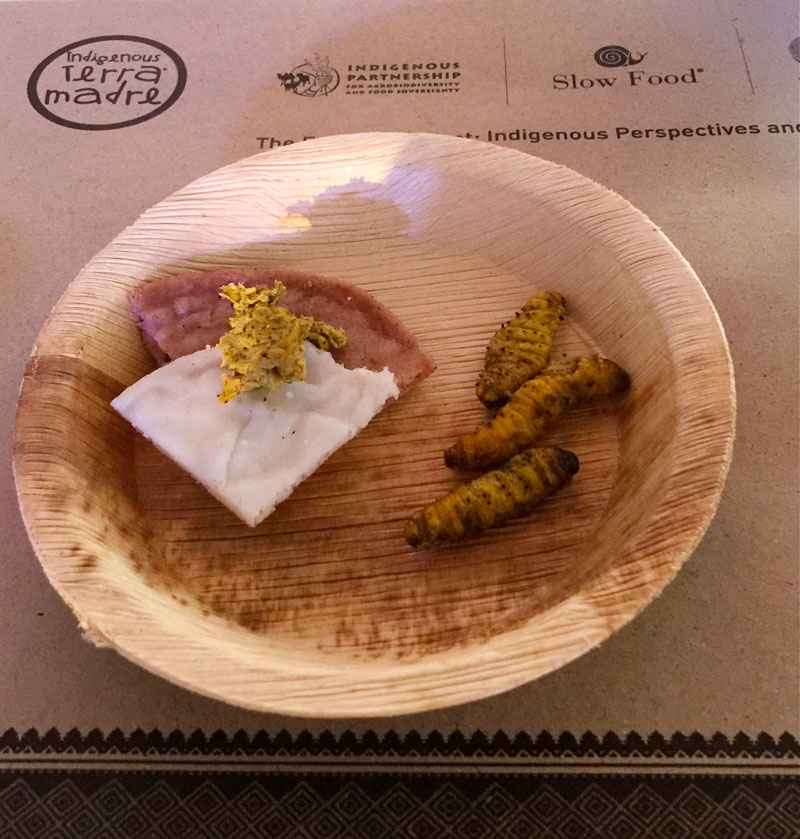
Despite the logic of consuming of insect protein, the next set of presentations are psychologically challenging to accept as food –I have to push the word ‘worm’ and all its connotations out of my mind before I can pop the plump Eri Silk Worms, deep fried in turmeric and oil, curled up on my plate, into my mouth. The silkworms taste delicious. The closest texture that comes to mind is prawn, and there is a distinct hint of fish roe to the flavour. Plantina Mujai, a Khasi lady who breeds silkworms for food, also has a delicious chutney served up with rice cakes. She speaks clearly and confidently in her native Khasi explaining the benefits of the fat and mineral content of silkworms that her people consume regularly.
A common pest that attacks rice crops, the Riverbed Beetle, has been cooked with onion, garlic, chili and tomato into a chutney with a faint crunch and an unfamiliar flavour. This distinctive taste also makes it a useful flavouring agent that is used with foods such as boiled fish. Jimsi Tassar from Arunachal Pradesh explains that the beetle hibernates on dried riverbeds and riverbanks through the winter, which is when the entire community sets out to hunt and eat them, taking care of a potential threat to their rice crop while supplementing their diet with rich protein.
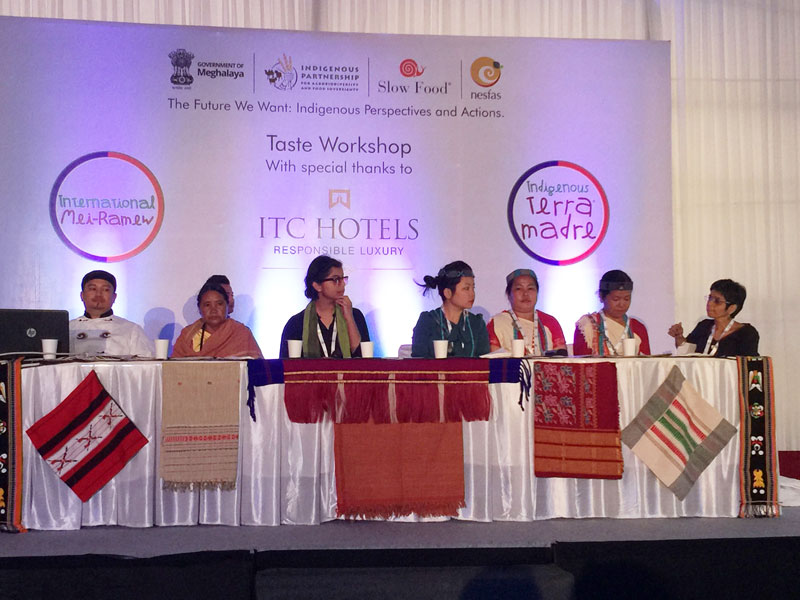
There is an immediacy to these first hand accounts of foods that appear exotic and strange to us, but have been an integral part of the food traditions and diets of people in other parts of the world for generations. When narrated by producers, growers, gatherers and indigenous farmers, they convey an important message about landscapes and carefully balanced ecosystems. These foods are part of a cultural identity, based on invaluable knowledge gathered over millennia that is in danger of being seriously eroded as standardization engulfs the way we produce and consume food.
The tasting workshops were a part of the second edition of the Indigenous Terra Madre held at Shillong, Meghalaya –the first was held in Sweden, in 2011. NESFAS, the North East Slow Food and Agroboidiversity Society, in association with the Indigenous Partnership and Slow Food, Italy, created a confluence of scientists, policy makers, farmers and producers to share a platform where they could exchange ideas to promote sustainable local food systems and protect biodiversity, while creating economies that will support young people in their indigenous cultural environments, helping them keep their heritage alive.
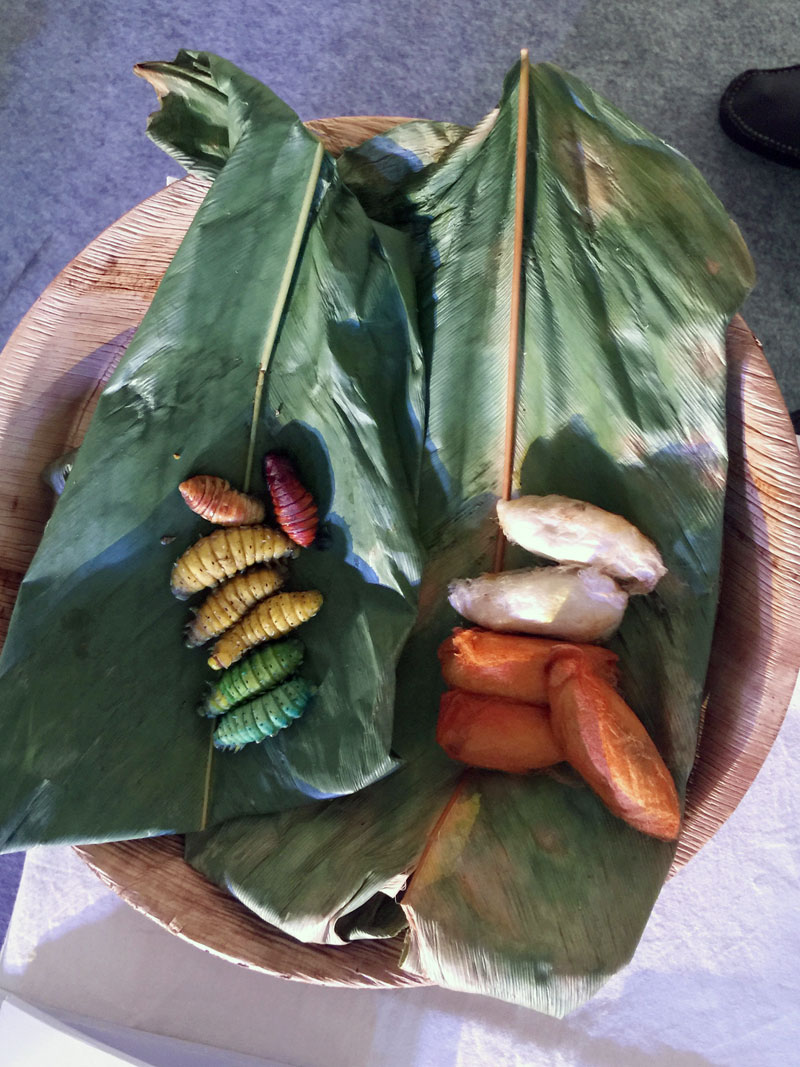
Milling around the NEHU (North-Eastern Hill University) campus, where most of the events spread over three days were held, were 600 delegates from 140 tribes across the globe, an affirmation of the diverse ethnic and cultural identities that have evolved in different environments. Each of them brought unique perspectives to how food could be produced and consumed, based on their interactions with the land in different parts of the world. The narratives we experienced with these participants at the taste workshops were not just food stories, but life stories. The bugs, grasshoppers, wild edibles, fermented foods and honey we ate are not crisis or famine foods for the people who consume them regularly, but nutritionally valuable and often prized parts of their traditional cuisines and cultures, the knowledge of how to use them gathered from a particular landscape and passed down the generations.
Chef Joel Basumatari from Nagaland is one of a growing number of young chefs going back to explore their own food histories. He presents an assortment of edible spiders, fat bamboo worms, fried bees and the prized Carpenter’s worm that he calls “the saffron of insects, which can cost up to Rs.2000 for 200gms, and is a much sought after delicacy.” With this plateful of bugs, he provides a link with the possibility of high-end gastronomy exploring new flavour profiles. Served up with sweet potato and a salsa of local tree tomatoes, it prompts us to think of the FAO recorded 1900 species of edible insects that enrich many diets across the globe.
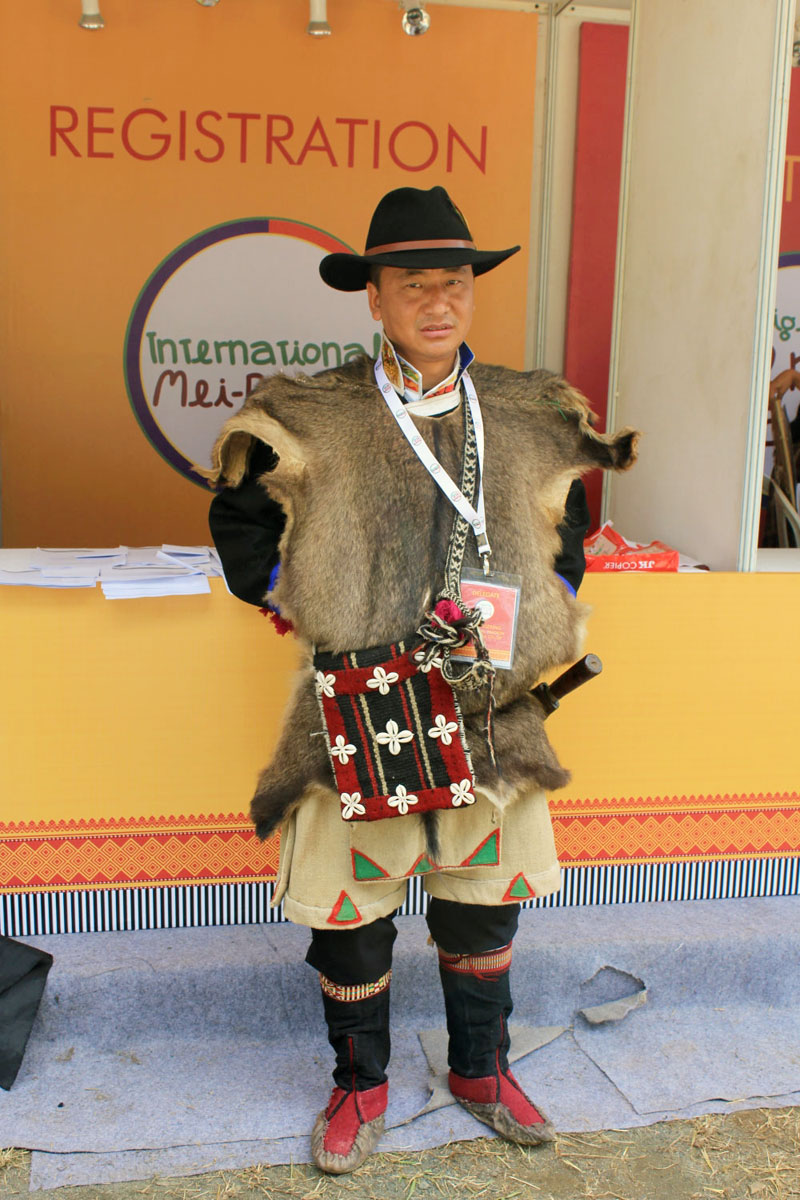
The real story here though, is not one of fine dining, but food security. At all the taste workshops there are narratives of how small communities of indigenous farmers, gatherers, and food producers have managed to revive dying food production practices and resist large scale, commercialized farming and monocultures to sustain their own food needs through diverse crop choices. The deep spiritual relationship that most traditional farmers have with the soil, something that is disappearing, was a thread of two inspiring accounts, both to do with rice, that came from different parts of the globe: Dr. Winona La Duke, an activist for Native American rights described how the Anishinaabeg people had fought for and succeeded in preventing the genetic manipulation of their native wild rice that holds many historic and sacred associations for her tribe. It was one of the highlights of the sessions, when we were able to eat some of that same rice they had fought so hard to preserve, at one of the taste workshops. Lamen Gonnay’s community of rice farmers from Kalinga, in the Philippines organized themselves into a cooperative to resist the spread of chemical farming, and grew and exported organic rice using traditional methods, and finally won government recognition.
For many, it is also about redressing a balance with the environment that has been upset. Sean Sherman, a Lakota Indian Chef from Minnesota explained how they were now harvesting wild ginger and potato during the few weeks in the year that these wild foods are available –but they ensured that enough was left behind in the landscape for the plants to regenerate, and for animals to forage. Wild edibles, packed with micronutrients and flavour, a long neglected category of foods now made famous by restaurants like NOMA in Copenhagen have been an important part of the cuisine of indigenous people for generations. So while Chef Sherman cooks sophisticated, modern meals using old, uncultivated, raw materials, he also works at revitalizing local food histories, teaching people their food heritage through those dishes. What chefs like Sherman and Basumarati do is break down the negative image of certain types of foods –foraged wild edibles and insects in this case –and put the pride back in indigenous peoples to take ownership of and develop their traditional cuisines. By cooking these marginal foods in high-end restaurants, they also educate people about valuable local food knowledge that has been gathered over time. Several other high end chefs play a similar role in expanding our food consciousness: the Nordic Food Lab, started by Rene Redzepi and Claus Mayer, for instance, researches wild foods and tries to turn ‘inedibles into edible ingredients for a future where everyone can not only eat but eat well’.

“The Future We Want” of the Indigenous Terra Madre is one where age old knowledge systems of diverse peoples can be understood and translated into urban agriculture and contexts: where we begin to look at food differently, so that ‘invisible’ foods such as self-sustaining, nutritious weeds even in city parks will provide opportunities for foraging and food gathering; and initiatives such as community vegetable gardens will make a much wider range of foods accessible to more people, all the while creating networks of people connected through food.
Tae-Kyung-Je from Korea struggles with the English language, but she has no difficulty in communicating the antioxidant and probiotic properties of kimchi and rice wine that have made fermented foods the subject of so many trendy cookbooks in recent years. She has been working on reviving traditional fermentation and flavouring techniques for rice wine that include wild yeast, infusions of seasonal flowers and medicinal herbs. She has brought samples to share, which are so good that supplies quickly run out. Tae-Kyung-je also touches on one of the most important aspects of kimchi making that is being lost: traditionally, it was a community activity where people gathered together, before the onset of winter, to make large quantities of kimchi and store it. In this and many other shared stories is the message of that all-important “we feeling” in food production something that we need to be looking at for a secure food future.
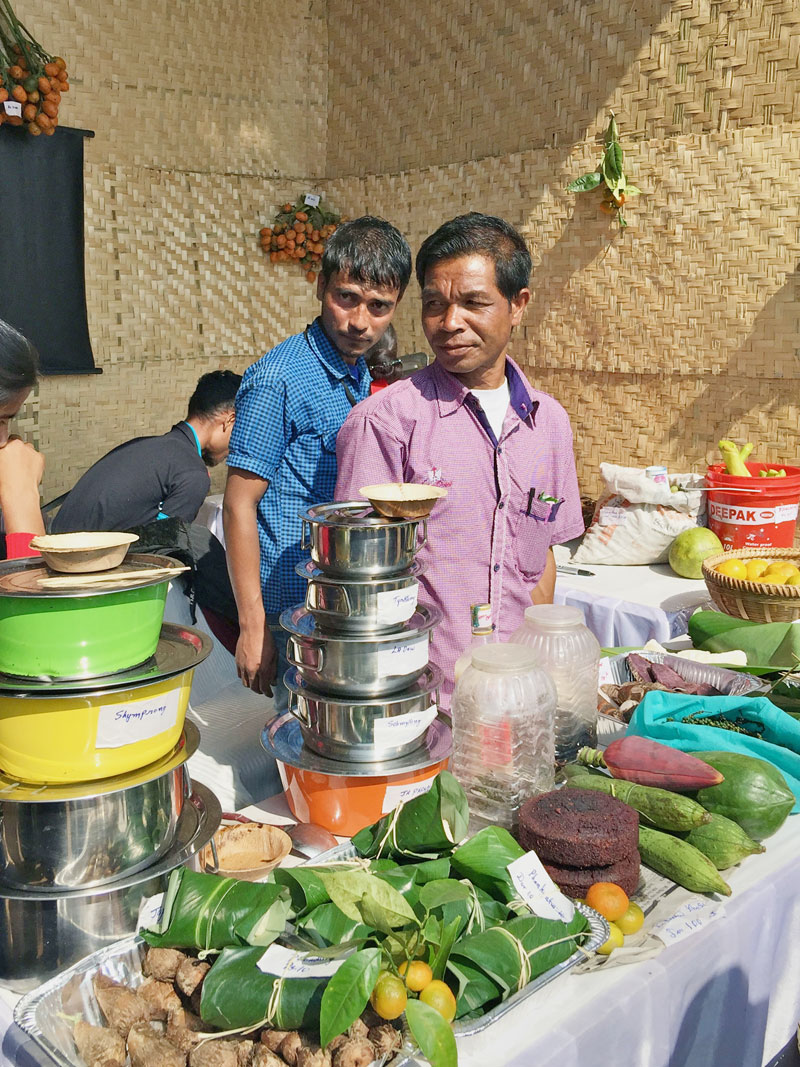
Chocolates embedded with crickets, Cricket Flour, Mealworm spreads, Cricket Pate are already being marketed in Western countries, and Baum and Whiteman, the restaurant consultants forecasted that insect protein powder would be amongst the hottest food and drink trends of 2015. But these are marketed mainly as niche, exotic foods and have very little to do with the dietary necessities of people, as the psychological “disgust factor” is still high in non-indigenous societies. Entomophagy, is still restricted largely to ethnic populations, and would need a major image-makeover before achieving anything like widespread acceptance. It is largely defined by cultural practices and inherited tastes. While we have a tradition of insects eating in the Central and North Eastern parts of India, the Central Sericultural Research and Training Institute in Mysore, and the Madhya Pradesh Silk Federation have met with little success in marketing the foods they have developed, such as canned silk work pupae. Researchers point out that there is little point in farming and freeze drying insects, transporting them across the globe and transforming them expensively into an acceptable form before they are consumed –it would defeat the main idea of using insects–sustainability. The vision is one of wild foods as part of a workable system that is seasonal, available and will provide food security to the maximum number of people. Ultimately, geography, landscape and culture will play a major role in deciding any food choices of the future, as they has always done.
At the end of the final workshop, I have a long list of alternative ingredients and food options that I have learned about: hibiscus leaf starters; natural yeast from lotus leaves; edible flowers for colouring agents. So many voices from so many different cultures, so many rich options for different ways of producing good food locally that can be made accessible to the largest number of people –can there really be any justification for narrowing our vision to just a few ways of producing and consuming food?
This article appeared in UpperCrust Magazine, Volume 17, First Quarter 2016.
Image Credits: K.P.Ponnapa




